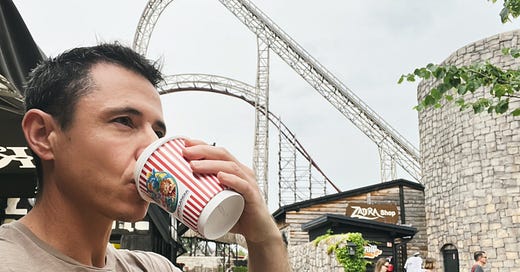Good Morning!
I’m writing to you from the future! It’s Friday night in Poland 🇵🇱, where I’m sitting in a cafe at Energylandia, one of Europe’s most popular roller coaster amusement parks. Despite being summertime, it’s nearly empty due to the severe thunder storm warnings in the area.
Roller coasters aren’t my thing, but my sons love them. I’ve been enjoying my time waiting outside the rides, sipping cappuccinos and people watching.
The food, beverages, and service are excellent at the park, and even though I don’t speak Polish, most of the employees understand very basic English (hi, toilet, Pepsi, coffee, chicken, fries, card, cash, gas water, and thanks), and intentional gesturing. This trip has reinforced for me that when spoken language barriers exist, it’s important to be cognizant of your body language, as well as the other person’s body language, for effective and positive communication.
One thing for you to think about
Whether you’re traveling abroad or communicating with someone who’s not fluent in English in the US, your body language and facial expressions make a HUGE difference in the outcome of the conversation.
Not only that, but anytime you’re meeting new people (including potential romantic partners) body language and facial expressions play a huge role in developing a rapport.
Here are indicators of an interaction that’s going well:
Smiling
Nodding yes
Eye contact
Relaxed / open stance (shoulders forward, arms uncrossed)
Enunciating and speaking more clearly
Conversely, here are indicators of a convo that’s not getting anywhere:
Frowning or confused looking
Eyes looking away or rolling
Shaking head no or shrugging
Raising volume for no reason
Not slowing down speech and/or speaking even faster
Side-facing or starting to turn away
Arms folded
Discovery: Every day is an opportunity to learn more about yourself and others. Reflect on these ideas and consider sharing.
Two things for you to ask yourself
If you’ve traveled abroad, can you remember times that non-verbal communication has been successful versus unsuccessful? What were the differences?
If you communicated recently with a non-English speaker in the US, how did body language factor into it?
Ideation: Use these questions as prompts and write down your responses and ideas.
One thing for you to try
You can experiment with body language using a mirror or by recording yourself. Practice making eye contact, smiling, nodding, standing relaxed (but not slouchy), and keeping your arms natural (ie unfolded/uncrossed).
Experiment: Growth happens when you step outside of your comfort zone and make brave choices. Reply to this email or leave a comment and let me know how it went.
Signing off from Poland 🇵🇱🎢⛈️—see you on the 12 hour flight back to Los Angeles!
Liked what you read? Share it with a friend!





